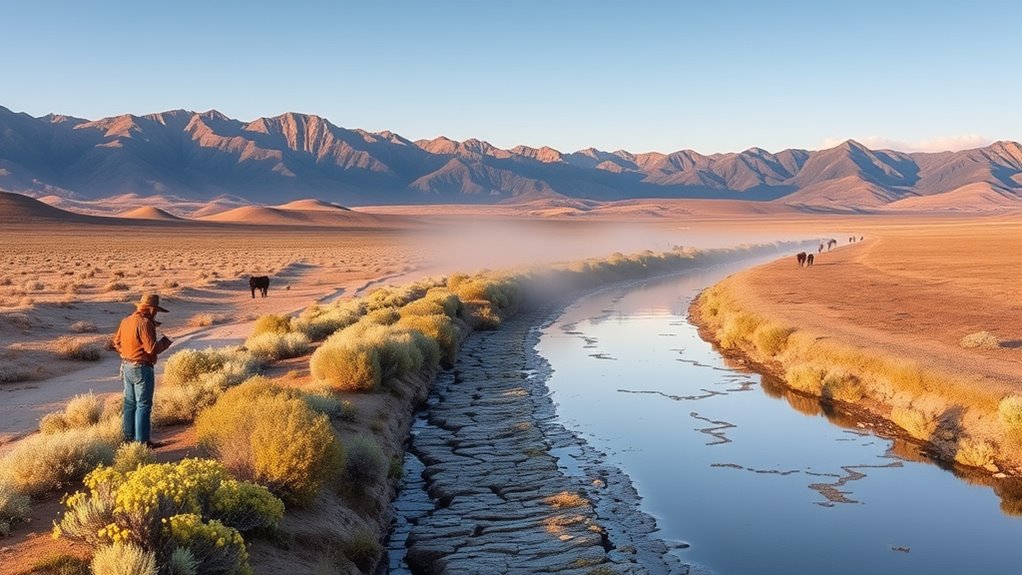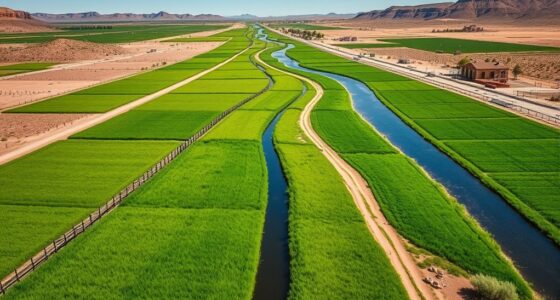Nevada ranchers have survived by carefully maneuvering the state’s complex water rights laws and management reforms. They rely on the prior appropriation doctrine, securing water rights through permits and early use. Groundwater management agencies monitor water levels and enforce sustainable pumping limits, helping ranchers plan their withdrawal. These efforts, combined with legal reforms promoting responsible use, have allowed ranchers to adapt and secure their livelihoods. To discover how these strategies continue shaping their future, explore further details below.
Key Takeaways
- Ranchers secured water rights through the prior appropriation system, emphasizing historical use and permits.
- Water law reforms clarified and regulated groundwater rights to prevent over-pumping and conflicts.
- Groundwater monitoring systems helped ranchers plan water use and avoid aquifer depletion.
- Local agencies oversee basin health, enforce sustainable pumping limits, and support legal compliance.
- Participating in groundwater management efforts ensured long-term water access for ranching survival.

Have you ever wondered how water rights are managed in Nevada? It’s a complex system, especially for ranchers who depend heavily on groundwater for their livelihood. The state’s approach to groundwater management has evolved over the years, shaped by a series of water law reforms that aim to balance agricultural needs with the sustainability of water supplies. Unlike surface water, which is often more straightforward to allocate through stream rights, groundwater rights are less visible but equally essential for farming and ranching communities. These reforms were introduced to address issues of over-pumping and to create a more structured legal framework for groundwater use. As a rancher, you need to understand that groundwater in Nevada is largely governed by the prior appropriation doctrine, meaning rights are based on historical use and permits. This system encourages efficient water use but also puts a premium on securing and protecting your rights before others do. The state’s water law reforms aimed to clarify and regulate groundwater rights, reducing conflicts and encouraging sustainable practices. They introduced monitoring and data collection systems, helping ranchers and regulators track groundwater levels more accurately. This transparency allows you to plan your water use more effectively, knowing how much is available and how much you can draw without risking depletion. These reforms also promote conjunctive use, encouraging the combined use of surface water and groundwater to optimize resources. For ranchers, this means you can adapt your practices to incorporate both sources, reducing the pressure on aquifers and ensuring water availability for future seasons. Additionally, groundwater monitoring systems have been improved to help prevent over-extraction and protect against aquifer depletion. The reforms also emphasize the importance of local groundwater management agencies, which oversee groundwater basins and implement sustainable pumping limits. If you’re part of a local water district, you’ll find that these agencies are there to help you navigate your rights and responsibilities, ensuring your operations are compliant with the law while safeguarding the basin’s health. Overall, the management of groundwater in Nevada remains a dynamic process, balancing the needs of ranchers with ecological and societal concerns. The water law reforms serve as a framework to promote responsible use, preventing over-extraction and promoting long-term sustainability. As a rancher, staying informed about these reforms and participating in groundwater management efforts can help you secure your water rights and ensure your livelihood endures for generations to come. Managing groundwater wisely isn’t just about legal compliance; it’s about securing your future in an arid landscape that demands careful stewardship and proactive adaptation.
Frequently Asked Questions
How Have Climate Changes Impacted Water Availability for Ranchers?
Climate changes have markedly impacted your water availability, forcing you to adapt through climate adaptation strategies. Droughts have become more frequent and severe, challenging your water sources and livestock sustainability. To build drought resilience, you implement water conservation practices, diversify water sources, and adjust grazing patterns. These efforts help you manage scarce water resources effectively, ensuring ranch survival despite changing climate conditions.
What Legal Battles Have Shaped Water Rights in Nevada?
Water law in Nevada has been shaped by landmark legal battles that set essential precedents, like the Winters Doctrine and the McCarran Amendment. These cases act as guiding stars, ensuring ranchers can access water resources despite conflicts. You must understand that these legal precedents, often fought fiercely in court, determine your rights, protecting your access to critical water supplies and shaping Nevada’s future water landscape.
How Do Water Rights Affect Ranchers’ Land Use Decisions?
Water rights heavily influence your land use decisions, especially regarding water transfer and land prioritization. If you hold senior rights, you can use water more freely, but if your rights are junior, you might need to prioritize land that’s most critical for your operation. Water transfer can help optimize resource use, but you must navigate legal constraints, making strategic land and water management essential for sustaining your ranch.
Are There Government Programs Assisting Ranchers With Water Rights?
Think of federal assistance as a lifeline that helps you navigate water rights challenges. Yes, there are programs like the Bureau of Reclamation grants and water conservation initiatives designed for ranchers. These programs support sustainable water use and sometimes provide funding or technical help. By participating, you guarantee your land remains viable, much like a well-tended stream that sustains the entire ecosystem. This aid keeps your operation afloat and promotes responsible water management.
How Do Water Rights Influence Sustainable Ranching Practices?
Water rights directly shape your sustainable ranching practices by controlling water allocation and enabling rights transfers. When you secure clear rights, you can plan water use efficiently, ensuring your land stays healthy and productive. Rights transfers allow flexibility, letting you adapt to changing needs or conserve resources. Proper management of water rights encourages responsible use, helping you maintain a viable ranch while protecting water supplies for future generations.
Conclusion
You’ve seen how Nevada ranchers fought against impossible odds, wrangling water rights like legendary cowboys battling on dry, cracking plains. Their resilience defied nature’s fiercest fury, turning drought into a mere hiccup. If you think surviving isn’t heroic enough, think again—these ranchers tamed the wildest waters and made history, all with grit, guts, and a stubborn refusal to give up. Their story isn’t just about water; it’s about unstoppable spirit.










